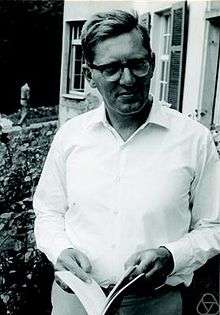Nicolaas Govert de Bruijn
| Nicolaas Govert de Bruijn | |
|---|---|
 | |
| Born |
9 July 1918 The Hague |
| Died |
17 February 2012 (aged 93) Nuenen |
| Nationality | Dutch |
| Fields | Mathematics |
| Institutions | Eindhoven University of Technology |
| Alma mater | Vrije Universiteit Amsterdam |
| Doctoral advisor | Jurjen Ferdinand Koksma |
| Doctoral students |
Matheus Hautus Antonius Levelt Robert Nederpelt Lazarom Johannes Runnenburg Stan Ackermans |
| Known for |
De Bruijn sequence De Bruijn index Automath |
Nicolaas Govert (Dick) de Bruijn (Dutch pronunciation: [nikoːˈlaːs ˈxoːvərt də ˈbrœy̯n];[1] 9 July 1918 – 17 February 2012) was a Dutch mathematician and Emeritus Professor of mathematics at the Eindhoven University of Technology, noted for his many contributions in the fields of analysis, number theory, combinatorics and logic.[2]
Biography
Born in The Hague, De Bruijn received his MA in Mathematics at the Leiden University in 1941. He received his PhD in 1943 from Vrije Universiteit Amsterdam with a thesis entitled "Over modulaire vormen van meer veranderlijken" advised by Jurjen Ferdinand Koksma.[3]
De Bruijn started his academic career as at the University of Amsterdam, where he was Professor of Mathematics from 1952 to 1960. In 1960 he moved to the Technical University Eindhoven where he was Professor of Mathematics until his retirement in 1984.[2] Among his graduate students were Johannes Runnenburg (1960), Antonius Levelt (1961), S. Ackermans (1964), Jozef Beenakker (1966), W. van der Meiden (1967), Matheus Hautus (1970), Robert Nederpelt Lazarom (1973), Lambert van Benthem Jutting (1977), A. Janssen (1979), Diederik van Daalen (1980), and Harmannus Balsters (1986).[3]
In 1957 he was appointed member of the Royal Netherlands Academy of Arts and Sciences.[4] He was Knighted with the Order of the Netherlands Lion.
Work
De Bruijn covered many areas of mathematics. He is especially noted for:
- the discovery of the De Bruijn sequence,
- discovering an algebraic theory of the Penrose tiling and, more generally, discovering the "projection" and "multigrid" methods for constructing quasi-periodic tilings,[5][6]
- the De Bruijn–Newman constant, the De Bruijn–Erdős theorem in both incidence geometry,
- graph theory,
- the BEST theorem, and
- De Bruijn indices.
He wrote one of the standard books in advanced asymptotic analysis (De Bruijn, 1958).
In the late sixties, he designed the Automath language for representing mathematical proofs, so that they could be verified automatically (see automated theorem checking). Shortly before his death, he had been working on models for the human brain.
Publications
Books, a selection:
- 1943. Over modulaire vormen van meer veranderlijken
- 1958. Asymptotic Methods in Analysis, North-Holland, Amsterdam.
Articles, a selection:
- de Bruijn, Nicolaas Govert. "A combinatorial problem", 1946. In Proceedings of the Section of Sciences, Vol. 49, No. 7, pp. 758–764. Koninklijke Nederlandse Akademie v. Wetenschappen.
- de Bruijn, Nicolaas Govert. "The mathematical language AUTOMATH, its usage, and some of its extensions." Symposium on automatic demonstration. Springer Berlin Heidelberg, 1970.
- de Bruijn, Nicolaas Govert. "Lambda calculus notation with nameless dummies, a tool for automatic formula manipulation, with application to the Church-Rosser theorem." Indagationes Mathematicae (Proceedings). Vol. 75. No. 5. North-Holland, 1972.
See also
References
- ↑ In isolation, Govert is pronounced [ˈɣoːvərt].
- 1 2 Nicolaas Govert de Bruijn's obituary 2012
- 1 2 Nicolaas Govert de Bruijn at the Mathematics Genealogy Project
- ↑ "Nicolaas Govert de Bruijn (1918 - 2012)" (in Dutch). Royal Netherlands Academy of Arts and Sciences. Retrieved 17 July 2015.
- ↑ N. de Bruijn, "Algebraic theory of Penrose's non-periodic tilings of the plane. I" (1981)
- ↑ N. de Bruijn, "Algebraic theory of Penrose's non-periodic tilings of the plane. II" (1981)
External links
- Nicolaas Govert de Bruijn's obituary
- Bruijn N.G. de at win.tue.nl (in Dutch)